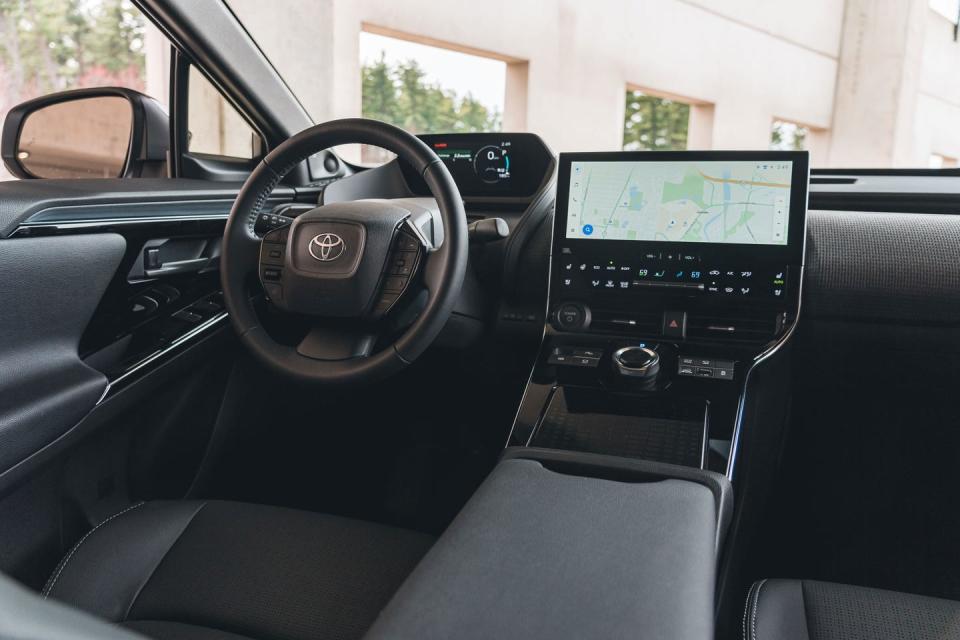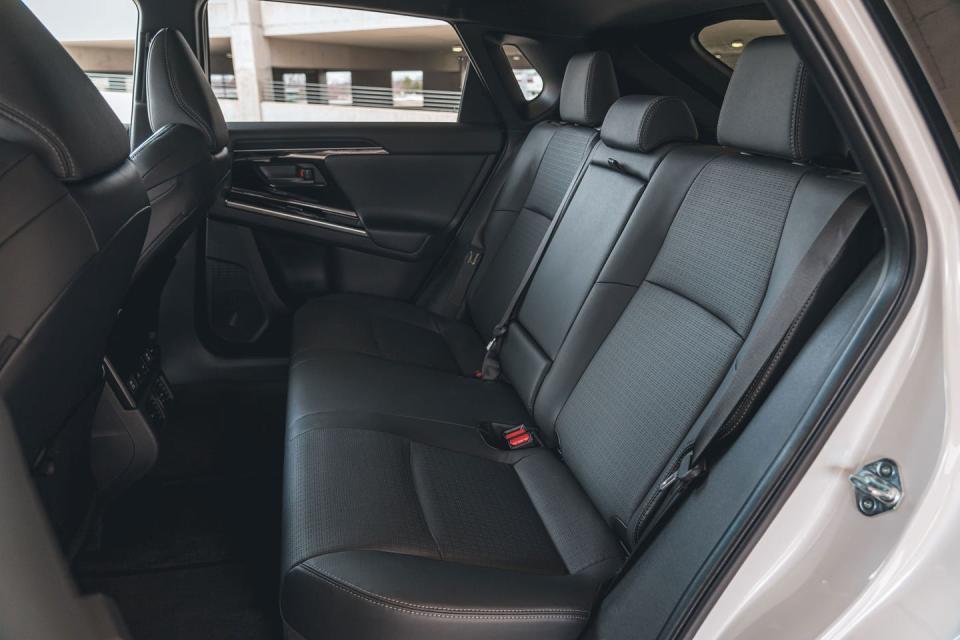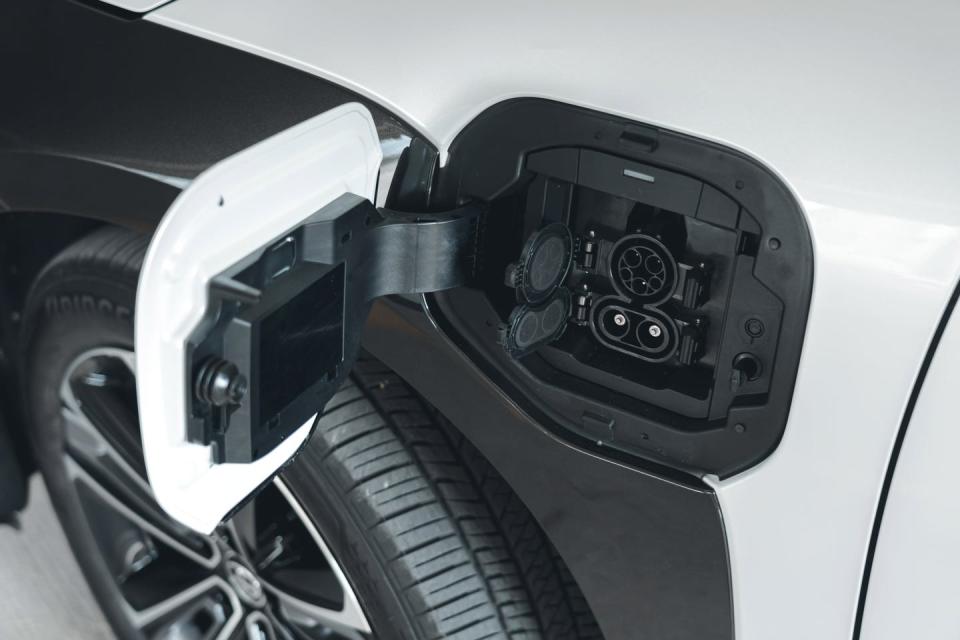Tested: 2023 Toyota bZ4X Gets Toyota into the EV Game

UPDATE 5/3/22: This review has been updated with test results.
Ever since the introduction of the Prius, Toyota has been the league leader in hybrids, fielding an impressive roster of gas-electric models. In EVs, however, Toyota has mostly been content to watch from the stands—excepting a couple of seasons in the minors with the RAV4 EV sold in California in 1997 and again in 2011. Now, finally, Toyota is stepping up to the plate with the bZ4X, an EV that will be sold nationwide. It's a cautious effort that doesn't swing for the fences.
Although the name would appear to be the result of a product planner pounding a fist on a keyboard, Toyota says bZ stands for "beyond Zero" emissions, the 4 indicates the vehicle's size, and X denotes its SUV body style. More electric bZ models will follow, the next likely to be a Highlander-sized bZ5X SUV.

Slightly longer and lower than the RAV4, the bZ4X was co-developed with Subaru, which is fielding the nearly identical Solterra. The designs are differentiated mostly up front, where the bZ4X gets a trapezoidal non-grille while the Solterra's is hex shaped. Both have the same side sculpting and heavy black plastic elements over the wheel arches. Taking a page from Tesla, there's just one standard color: black. White, red, silver, and gray cost $425 extra and in the Limited can be paired with a black roof for $500.
The major difference between the two models is that Toyota offers a front-wheel-drive single-motor version as well as an all-wheel-drive dual-motor variant, whereas Subaru went exclusively all-wheel drive. Either bZ4X powertrain can be had in XLE or Limited trim. The standard setup produces 201 horsepower, a respectable number that exactly matches the single-motor Volkswagen ID.4 and Kia Niro EV. We expect the FWD bZ4X to hit 60 mph in just under seven seconds, which would be better than the 7.6 seconds we achieved with the VW but slower than the 6.2 we recorded with the Kia.

What's unusual, however, is that while other automakers position their all-wheel-drive dual-motor EVs for high performance, the dual-motor bZ4X adds just 13 ponies, for a total of 214 horsepower. That stands in stark contrast to the similarly configured versions of the ID.4 (295 horsepower), the Hyundai Ioniq 5 and Kia EV6 (320 horses), and the Polestar 2 (408 horsepower).
Toyota claims that it wanted a similar driving character for both models, although the real reason is probably to keep some separation between the bZ4X and the mechanically similar Lexus RZ450e, which uses the 201-hp front motor and 107-hp rear for 308 horsepower combined. Either way, the all-wheel-drive version has superior off-the-line traction, with our AWD Limited test car reaching 60 mph in 6.3 seconds. Unfortunately, the dual-motor ID.4 is notably quicker at 5.4 seconds, and the Hyundai Ioniq 5 and Kia EV6 are even more so at 4.5 seconds.

In our drive around suburban San Diego, the two bZ4X powertrains felt equally spry. Both have satisfying, but not eye-widening, initial response pulling away from a stop or accelerating to pass on the freeway. Additionally, the chassis felt taut but compliant over bumps, and the steering has a decent amount of weighting. A button on the console boosts regenerative braking, though not to the level of one-pedal driving. Stopping from 70 mph in the AWD Limited model takes 174 feet, about average for the segment.
The all-wheel-drive version includes more than the typical off-road gear, courtesy of Subaru. There's hill-descent control, plus X-Mode programming that includes two off-road modes. There's also a brake-based system to send torque across either axle when one wheel loses grip. We didn't have an opportunity to go off-pavement with the bZ4X, but we did with its Subaru sibling, which acquitted itself well on some sandy off-road trails.


The two bZ4X models have nearly identical battery sizes of 63.4 kWh (in the single-motor version) and 65.6 kWh (in the dual motor). Their EPA range estimates are adequate but not class leading: 242/252 miles (Limited/XLE) for the front-drive version and slightly lower for the all-wheel-drive model at 222/228 miles. In our highway-range test, the dual-motor Limited was good for only 160 miles, which ties the Nissan Leaf down near the bottom of our EV-range results.
Toyota includes a year of free charging at EVgo locations, and buyers can bundle a ChargePoint Level 2 home charger as part of their purchase for $699 (which doesn't include installation). With a Level 2 supply, the modest 6.6-kW onboard charger can replenish the battery in about 11 hours. The bZ4X can also power up at a DC fast-charger, where Toyota claims that adding 80 percent charge takes just under an hour, with peak charging rates of 150 kW for the front-drive variants and 100 kW for the all-wheel-drive models. In other markets, the bZ4X offers solar panels integrated into the roof, but that feature didn't make the cut for the U.S.

U.S. cars do get a fixed glass roof as standard, which makes the interior feel airy. Thin pillars aid outward visibility. The rear seat cushion is low, allowing for adequate headroom, and rear legroom is generous. An optional feature in the Limited is a radiant heating element in the lower dash that warms the legs of front-seat occupants. A high center console bisects the front seats and has a wireless charging pad and a large open stowage space underneath. There's no glovebox or frunk, and the rear cargo hold can swallow 26 to 28 cubic feet (versus 38 for the RAV4). Unlike in Prius models, the bZ4X's digital instrumentation display is directly in front of the driver. But it's positioned so that you look over the steering wheel at it, and drivers who prefer a higher wheel position may find the display partially obscured. A 12.3-inch center touchscreen boasts sharp graphics and wireless phone mirroring but uses silly plus and minus buttons for volume and onscreen touchpoints for audio tuning. Subscribe to Wi-Fi and you can stream music via your Apple or Amazon music account. Navigation and "Hey, Toyota" voice recognition both are subscription based as part of Toyota's Drive Connect service, with three years gratis.

The bZ4X XLE starts at $43,215 and the Limited at $47,915. Upgrading to the all-wheel-drive dual-motor powertrain costs $2080. All models include adaptive cruise control, lane-departure warning, lane-keeping assist, blind-spot monitoring, rear-cross-traffic alert, and Safe Exit Assist. The Limited's additions include a motion-activated power liftgate, a heated steering wheel, heated and ventilated front seats, a multiview camera system, 20-inch wheels, and Softex faux-leather upholstery. Sales have already kicked off in ZEV states, and the bZ4X will be offered nationwide by the end of the year. Note that Toyota's $7500 federal EV tax credit is likely to start phasing out in the fourth quarter of this year—mostly thanks to the 150,000 or so Prius Primes sold since 2017—so interested buyers may want to move quickly, even if Toyota itself was a slow to get into the EV game.

You Might Also Like

 Yahoo Autos
Yahoo Autos 
